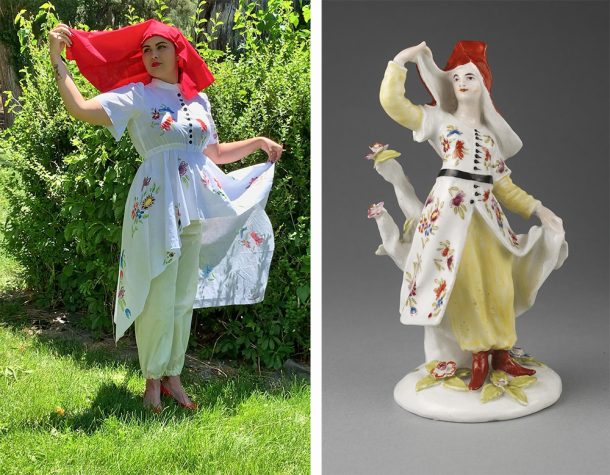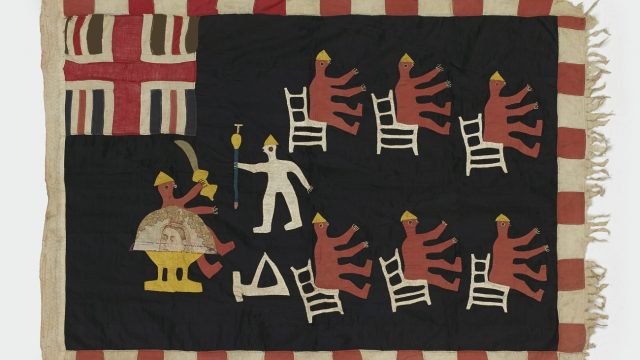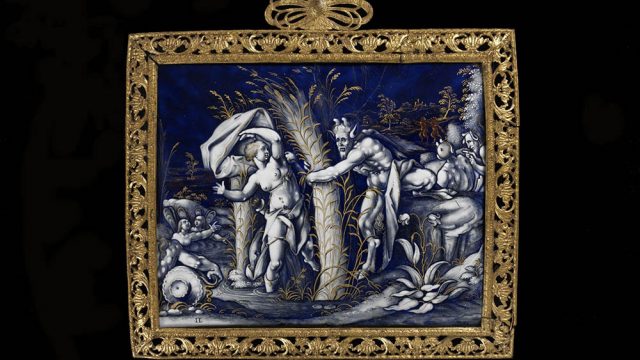Since January 2020, 23 students from the University of East London studying for an MA in Acting or Theatre Directing have been working with the V&A to devise new performance works inspired by our ceramics collection. Central to their investigation was East London’s Bow Porcelain Factory. Established in the 1740s, it was the first pottery in Britain that came close to emulating the fine porcelain made in China for 2000 years. This innovation was achieved by mixing the ash of bones from Smithfield’s meat market with kaolin, a fine clay mineral, that was mined by the Cherokee indigenous peoples of the Southeastern Woodlands in what English colonisers called North Carolina.
The students spent two days at the V&A where they undertook archival and object-based research into the Bow Porcelain Factory. For participant Chelsea Page Butler, through handling the objects she was fully able to appreciate that each piece of porcelain represented a ‘slice of someone’s life’. In groups, the students responded artistically to their research and devised their new works to question how pieces of Bow porcelain are repositories of hidden knowledge of domestic work, crime, labour or flirtation.
Originally the students’ new works were to be performed at the V&A. But when the coronavirus pandemic intervened, each group had to find new ways to make theatre collaboratively once their workshops were moved online. The students developed techniques to devise concepts, scripts, dance and performance together using digital platforms, animation and film. The result is a remarkable set of performances that not only shine new light on aspects of the V&A’s ceramics collection, but also attest to the digital creativity of theatre practitioners.

Each group sought to embody aspects of an object’s history. The radio play Display Purposes Only began from three Bow porcelain figurines of black domestic servants and one of the actress Kitty Clive. These figurines were displayed at grand dinners during the dessert course, some designed to hold candles or jellied sweets, their porcelain bodies associated with edibility and excess.
The group decided to dramatise a fictional dinner where the actress Kitty Raftor dined with her future husband, Lord Clive, served by a group of black domestic servants who we hear talking and singing in the kitchen. The Bow porcelain figurines are brought out with the desserts, but they turn out not to be passive: they have the voices of the real domestic servants and pass judgement on the conversation happening around and about them. At the end of the dinner Lord Clive suggests Kitty might want to take a figurine with her. She deliberates:
Kitty – Let me see… I will take this one of the young man on the pedestal holding the basket with those cotoniacks inside!
Clive – I believe that is a woman, Miss Kitty.
Kitty – Fancy! I would never have been able to make that distinction, even if I look upon it closer.
Kelis – These titties are on lockdown under this binder.
Head servant – They’re trying to take away our sexuality so they don’t get too turned on by our bodacious figures.
The script explores the racist ideologies contained within Bow porcelain figurines and, through imagined dialogue, offers a powerful vision of the lost histories of Black experience of domestic service in Georgian Britain.
Another element of grand dining was the starting point for another group’s piece: cleaning up after an elaborate dinner meant washing up over 500 pieces of porcelain, glassware and silverware. The Disposables charts a personal family history of a life in service retold through the performance of washing-up, sea-shanties and plate-breaking. The labour of professional domesticity impacts the body and becomes hereditary, points out the words of the opening song:
Her mouth is as red as, as red as her hands,
To me, wey hey, blow the man down.
her hands are as red as, as red as her Mam’s
Give me some time to blow the man down.
My mouth is as red as, as red as my hands,
To me, wey hey, blow the man down.
my hands are as red as, as red as my Mam’s
Give me some time to blow the man down.
Words taken from The Disposables (© Anna Robinson, Adrian-Vergil Leca, Nosa Gabriel Iredia, Megan Harrison, Miguel Goncalves Alves)

Two groups looked at the combination of secrecy and skill required to make eighteenth-century ceramics. Recognising Wedgwood’s Women overlays a recreation of pottery manufacture with readings of extracts from Josiah Wedgwood’s letters about the women who worked for him. Many women were employed to paint porcelain but, despite their skill, they were paid less than half than their male counterparts.
The specialisation of making processes and skills is the focus of YAO 窑 (kiln), which foregrounds how entrepreneurial innovations in pottery manufacture in the eighteenth century led to the specialisation of workers’ labour: each person repeated the same small step so that many hands collaborated to make one piece. YAO is poetically focused on the process of making porcelain and how this can be shown through performance.

Big Trouble in Little England was inspired by the people who work in the museum and the action film franchise Fast and Furious. Two members of V&A staff try to outwit an art thief who wants to steal a porcelain vase made in Jiangxi province, China. Will they succeed?
You can find out by watching Big Trouble in Little England, and the other four performances, on Youtube.
Reflecting on the collaboration, Chris Spyrou, undertaking his MA in Acting at UEL, explained that the ‘V&A has given us the chance to research and find out more about their collection, which in return has allowed us to imagine and be as expressive as possible, in order to (co)-create a performance’. Through the students’ creativity the V&A is learning how performance-based research can uncover powerful object histories within the museum’s ceramics collection.



Thank you for the amazing words, Dr Georgia, and everyone at the V&A for their amazing help throughout the devising process.